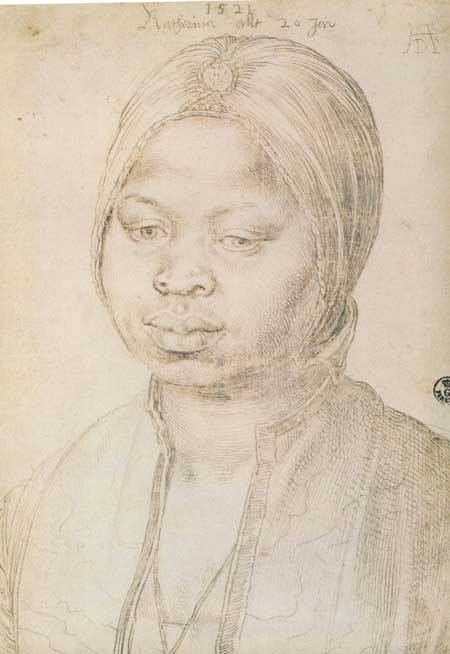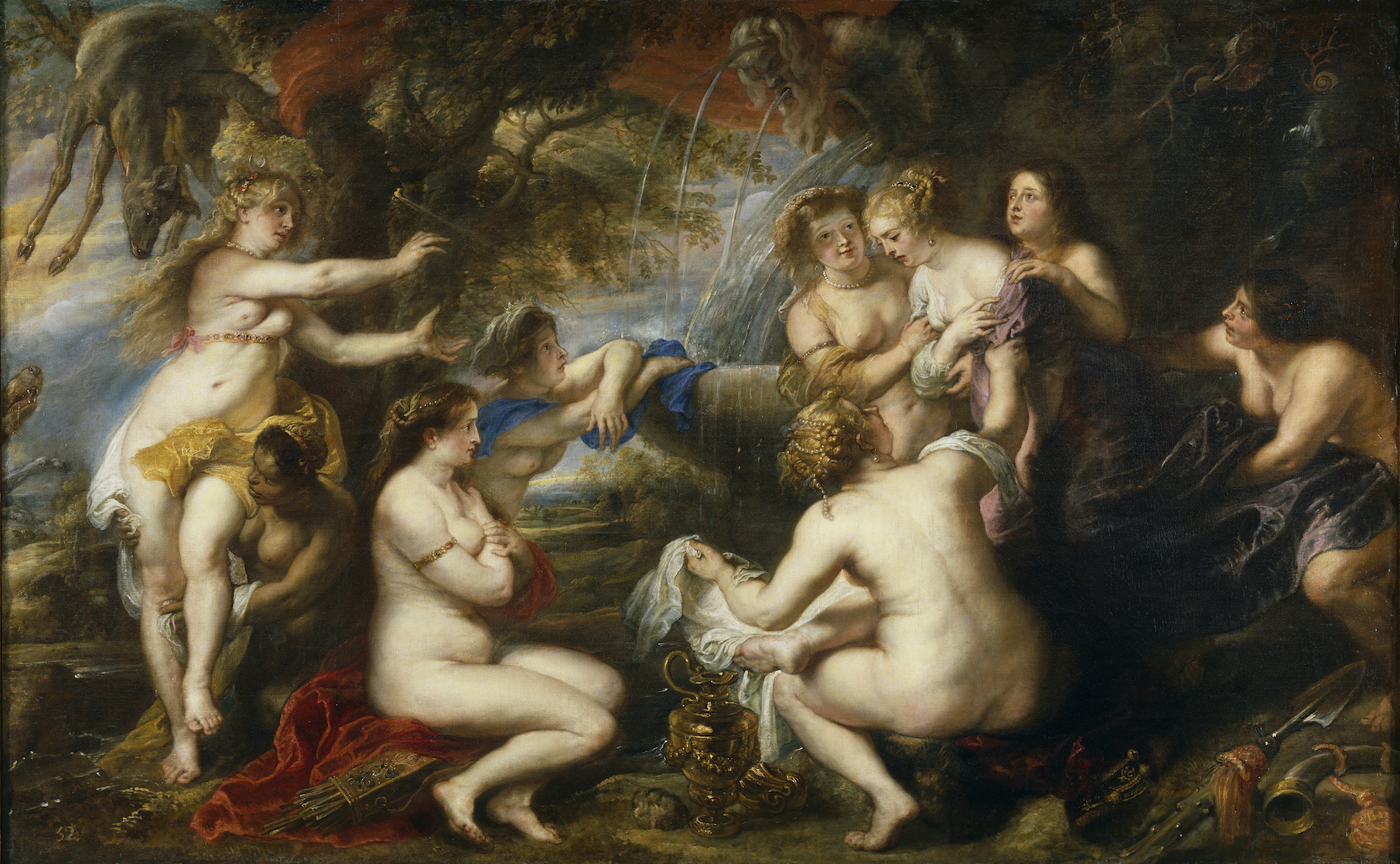The Low Countries
In the Low Countries, Antwerp had become a major commercial and financial center of western Europe by the early-sixteenth century, prospering from the profits of the spice and silver trades. During this period there were only a few documented cases of Black Africans who resided there. The majority lived in the trading cities of Antwerp and Bruges where they were brought as slaves and servants in Italian, Spanish, and Portuguese households.[24] Antwerp offered a flourishing artistic environment on a scale of Florence, Rome, and Venice.[25] Its economic success was attributed in part to its selection by the Portuguese as the principal European center of its trade with Benin in Africa.[26] Black Africans were sometimes transported from Benin to Antwerp; they could reside there as free people since slavery was outlawed, although it was tolerated for foreign visitors.[27] Such commercial routes increased the cultural exchange between Italy and the Low Countries. These strong urban economies led artists to be attracted to both Antwerp and Venice; some traveled between them and became influenced by each other’s work in the process. Examples of their works reveal both similarities and differences in approaches to depicting Black Africans.
Dutch involvement in the Atlantic slave trade extended through the seventeenth to nineteenth centuries. In the seventeenth century, the Netherlands begin to acquire wealth and profit through the exploitation of their colonies in North and South America. When the Dutch West India Company (WIC) conquers part of Brazil from the Portuguese in 1630, their interest in the African slave trade was sparked. Slavery and the slave trade were inextricably and irrepressibly a part of Dutch society, political traditions and social formation.[28] However, the appearance of Black Africans in the Low Countries had previously occurred much earlier, between AD 200 and 500 when they came to the region in the service of the Roman armies.[29] In 1436, soon after the Portuguese started exploring the African continent in search of trading opportunities, the first African slaves were shipped to Portugal. The Portuguese traded in return with goods obtained from the Spanish possessions of the Netherlands, thus explaining the early presence of Africans traveling with these merchants in Netherlandish trading cities such as Antwerp.[30]
Whether Black servants were free or enslaved, they had a very low social status. Having an African servant in one’s employment became a fashion that proved particularly popular in the Spanish Netherlands in the sixteenth century.[31] One of the first northern European nobles to be painted with a person of African descent was the English queen, Anne of Denmark (1574 – 1619). Painted by the Flemish artist Paul van Somer in 1617, Anne of Denmark (Fig. 2) depicts the queen standing facing half to the right, wearing a green riding habit and a tall-crowned hat with red plumes. Five greyhounds stare adoringly up at her as she holds a leash in her left hand and rests her right hand on her hip. To her right stands a tall brown horse and, further back, in the shadows, a Black African wearing scarlet and gold livery holds her horse to the left. This placement of the three figures where the black figure falls behind, even after the horse, displays his status even more clearly as there is a hierarchy between them. A likely inspiration for this painting was from the Italian painter Titian’s Laura dei Dianti (1520) (Fig. 19), which will later be discussed.
Although most of the images discussed in this project express racist conceptions of Black Africans by white artists and patrons, some northern European images convey sympathetic perspectives about their subjects. The depiction of Black Africans in roles not previously prescribed to them in iconography suggests that artists may have been painting from personal motivation. This is the case with the German artist Albrecht Dürer’s Portrait of Katharina (1521) (Fig. 3), which the artist completed during a visit to Antwerp. Dürer commented on his encounter with an enslaved woman of the household of the Portuguese trade commissioner João Brandão, with whom the artist resided, in a journal entry of 1521: an inscription at the upper center of the drawing identifies the figure as “Katharina” and her age as 20 years old. Brandão likely acquired her through his trade dealings; her name, derived from St. Catherine, implies she had converted to Christianity. Dürer’s choice to portray Katharina’s facial features and clothing in a naturalistic, non-exaggerative way humanized her rather than reducing her to a caricature.[32] Dürer’s image of Katharina quite clearly corresponds with this analysis and suggests a degree of sensitivity to the subject as an individual rather than a type. However, before Dürer’s encounter with Katharina in Antwerp, in his 1528 book On Human Proportion, he described Black Africans negatively: “Negro faces are seldom beautiful because of their very flat noses and thick lips; similarly, their shinbones and knees as well are too bony, not so good to look upon as those of the whites; and so also it is with their hands. Howbeit I have seen some amongst those whose whole bodies have been so well built and handsome otherwise that I never beheld finer figure, nor can I conceive how they might be bettered, so excellent were their arms and all their parts.”[33] This passage suggests that Dürer’s ambivalence about the physical characteristics of the Black Africans with whom he came in contact: he appreciated the form and strength of their bodies but found their facial features unattractive.
Other works by Antwerp artists conveyed and helped to uphold hierarchies of race. Peter Paul Rubens’ Diana and Callisto (1618) (Fig.4) illustrates Ovid’s mythological story in which Zeus, attracted to the nymph Callisto, took the form of Diana to seduce and rape her. Diana, goddess of the moon, the hunt and chastity, punished Callisto. Rubens depicts the most dramatic moment of the story as Diana and her nymphs prepare to take a bath and Callisto accidentally reveals her pregnancy. A Black African woman is shown intertwined between the white woman’s legs as she stares at the open mouth of a dog shown to the left of the painting.[34] The Black and white female bodies are fused into a single frame, as the dark-skinned woman grabs hold of Callisto’s clothing as she helps to get her dressed. This action of her dressing the white figure and the placement of her body below the other figures reduces her to an accessory present in the work to aggrandize a white figure, in this case a Roman goddess. It is also fair to argue the influence Titian had on Rubens depictions of Black Africans in his work for they are similar to that of Titian’s.
“Negro faces are seldom beautiful because of their very flat noses and thick lips; similarly, their shinbones and knees as well are too bony, not so good to look upon as those of the whites; and so also it is with their hands. Howbeit I have seen some amongst those whose whole bodies have been so well built and handsome otherwise that I never beheld finer figure, nor can I conceive how they might be bettered, so excellent were their arms and all their parts.”
Albrecht Dürer, 1528
(Fig. 2) Paul van Somer, Anne of Denmark, 1617. Oil on canvas.Royal Collection, LondonRoyal Collection Trust
(Fig. 3) Albrecht Dürer, Portrait of Katharina 1521. Silverpoint drawing on paper. Galleria degli Uffizi, Florence.
(Fig. 4) Peter Paul Rubens, Diana and Callisto, 1618. Oil on canvas. Museo del Prado, Madrid.



